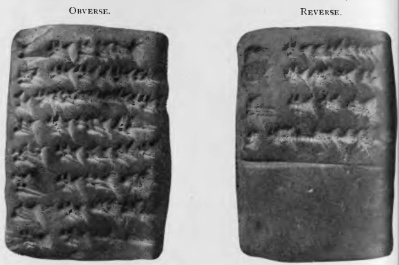Sargon and the Observations of Bel
“We know that Sargon’s patronage of science produced the great standard Babylonian work on astronomy and astrology, in seventy-two books, which went under the name of the Observations of Bel. It was translated into Greek by the Chaldean historian Bêrôssos, and large portions of it, including a table of contents, are among the tablets found on the site of the library of Kouyunjik.

This illustration is from a page on Babylonian astronomy hosted by the science faculty of the Mathematical Institute of Utrecht University.
http://www.staff.science.uu.nl/~gent0113/babylon/babybibl_fixedstars.htm
A dedicated work assessing the influences of Chaldean astrology on later Greek and Roman knowledge can be found in Franz Cumont, Astrology and Religion Among the Greeks and Romans, 1912.
Full text available for download at several locations on the net, including:
http://theosnet.net/dzyan/miscpubs/Astrology_and_Religion.pdf
In the course of centuries it had undergone a large amount of interpolation and addition; marginal glosses had crept into the text, and new paragraphs had been inserted recording the observations that had been made by the astronomers and astrologers of Babylonia during the whole length of the historical period.
In the form, therefore, in which it was edited for the library of Nineveh, it was very different from the original work that had been composed by the orders of Sargon. Old and new matter had been mixed up in it, and the enlargements introduced into it had probably nearly doubled its original size.

In the Fifth Tablet of the Creation Series (l. 2) the Signs of the Zodiac are called Lumashi 12 , but unfortunately no list of their names is given in the context. Now these are supplied by the little tablet (No. 77,821) of the Persian Period of which a reproduction is here given. It has been referred to and discussed by various scholars, and its importance is very great.
The transcript of the text, which is now published (see p. 68) for the first time, will be acceptable to the students of the history of the Zodiac. Egyptian, Greek, Syriac and Arabic astrological and astronomical texts all associate with the Signs of the Zodiac twelve groups, each containing three stars, which are commonly known as the “Thirty-six Dekans.”
The text of line 4 of the Fifth Tablet of the Creation Series proves that the Babylonians were acquainted with these groups of stars, for we read that Marduk “set up for the twelve “months of the year three stars apiece.” In the List of Signs of the Zodiac here given, it will be seen that each Sign is associated with a particular month.
http://www.sacred-texts.com/ane/blc/blc07.htm
http://www.sacred-texts.com/ane/blc/img/015.png
But the original work was itself a compilation of records and observations that had been made during an untold number of previous years. These records and observations had for the most part been written in Accadian; the result being that, although the astronomy of the Chaldeans, as we know it, is purely Semitic in form and character, many of its technical terms are non-Semitic, as well as the names of the celestial bodies.
Hence it is that we find a remarkable inconsistency between certain facts reported by the astronomical tablets and the astronomical system which they set before us. This astronomical system is based upon the assumption that the sun enters the first point of the constellation Aries at the time of the vernal equinox.
![http://doormann.tripod.com/asssky.htm Assyrian star map from Nineveh (K 8538). Counterclockwise from bottom: Sirius (Arrow), Pegasus + Andromeda (Field + Plough), [Aries], the Pleiades, Gemini, Hydra + Corvus + Virgo, Libra. Drawing by L.W.King with corrections by J.Koch. Neue Untersuchungen zur Topographie des Babilonischen Fixsternhimmels (Wiesbaden 1989), p. 56ff.](https://therealsamizdat.com/wp-content/uploads/2015/05/assyrian-star-map-from-nineveh.jpg?w=500)
http://doormann.tripod.com/asssky.htm
Assyrian star map from Nineveh (K 8538). Counterclockwise from bottom: Sirius (Arrow), Pegasus + Andromeda (Field + Plough), [Aries], the Pleiades, Gemini, Hydra + Corvus + Virgo, Libra. Drawing by L.W.King with corrections by J.Koch. Neue Untersuchungen zur Topographie des Babilonischen Fixsternhimmels (Wiesbaden 1989), p. 56ff.
The system must therefore have come into existence later than the 26th century before the Christian era, when Aries first became the starting-point of the Zodiacal signs. But the signs themselves were named, and the path of the sun through them was mapped out, when the vernal equinox still coincided with the sun’s entrance, not into Aries, but into Taurus.
The whole pre-Semitic nomenclature of the Zodiacal signs, and the months of the year that correspond to them, rests on the supposition that the Zodiacal bull ushers in the vernal year. Its Accadian name was “the directing Bull,” the bull that directs the course of the year; and the sign which faced it, the Scorpion of a later age, was correspondingly termed the star “that is opposite to the foundation” of the year.
We can now understand why the Sun-god Merodach, whom even the astronomers of the historical period continued to identify with the typical constellations of the twelve months of the year, should have been entitled “the Bull of Light” in the primitive astronomical records.
He was, in fact, the celestial bull who ploughed the great furrow of the sky, and from whom the first sign of the Zodiac borrowed its name. We may see in him the prototype of that famous bull of later legend whom Anu created in order to avenge upon Gisdhubar the slight offered by the latter to Istar.
The Sun-god eventually became the monster slain by a solar hero. Such are the results of time working upon the half-forgotten beliefs and tales of an earlier age.
Whiie in some instances the old totemistic conceptions were evaded by the degeneration of a god into a mere animal, in others the reverse process took place, the bestial element being eliminated from the nature of the god.”
A.H. Sayce, Lectures on the Origin and Growth of Religion as Illustrated by the Religion of the Ancient Babylonians, 5th ed., London, 1898, pp. 291-3.
